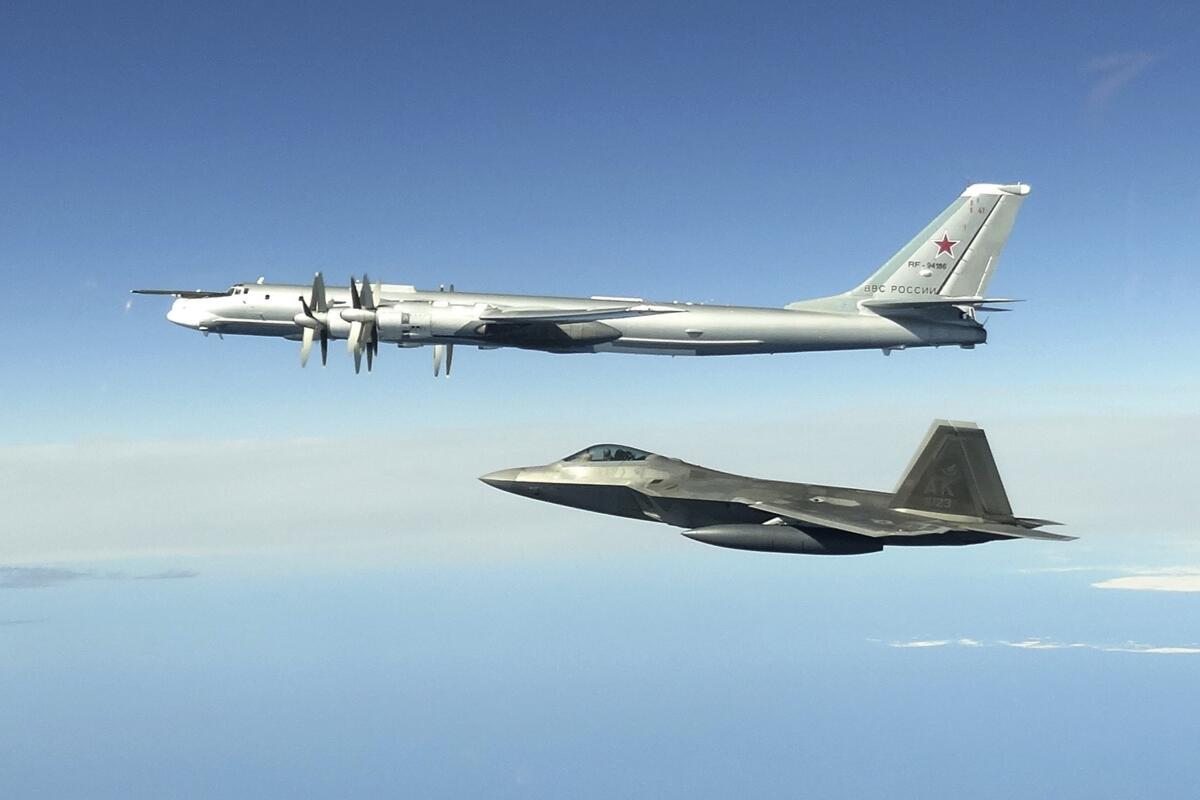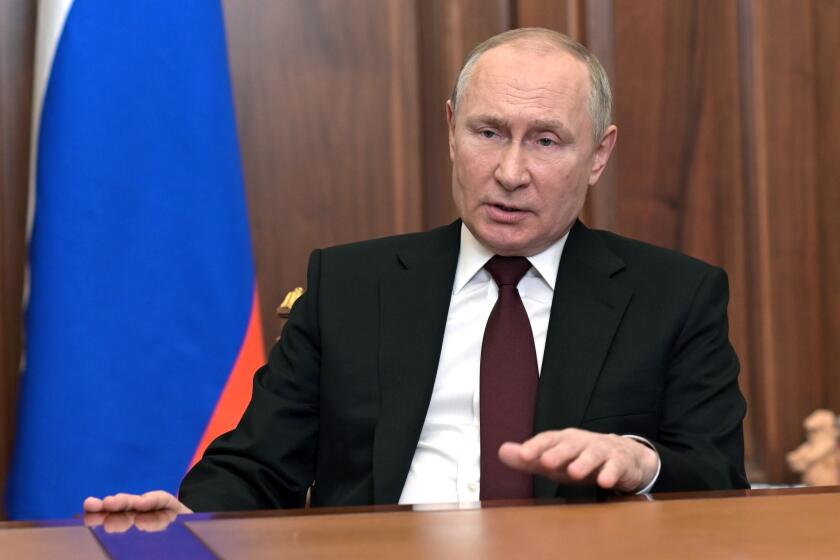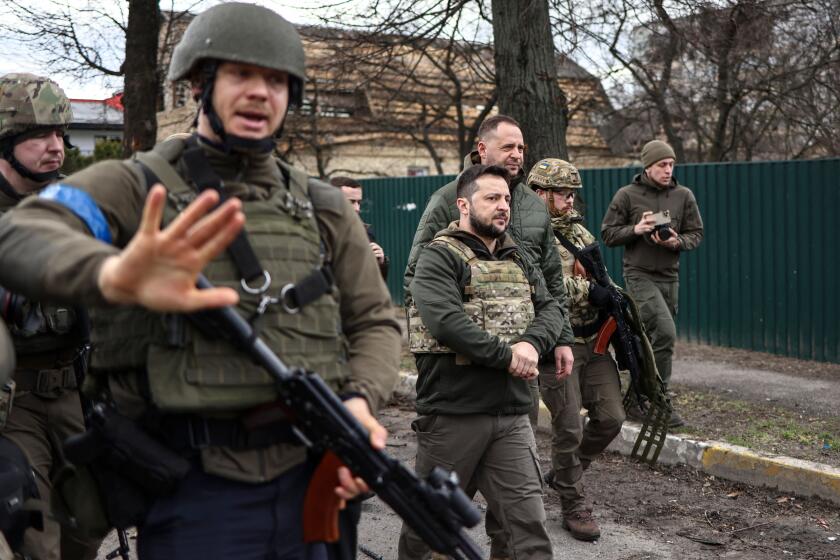Russia’s nuclear threat explained

- Share via
President Vladimir Putin conjured up the specter of nuclear war during the last week’s fierce fighting in Ukraine, instructing Russia’s military to place nuclear forces on “high combat alert,” a “special regime of combat duty.”
When was the last time there was a nuclear alert like this?
The last nuclear alert in a U.S.-Russian/Soviet crisis was by the United States during the 1973 Yom Kippur War, according to James Acton, who co-directs the Nuclear Policy Program at the Carnegie Endowment for International Peace. Before that, many experts say the closest the Cold War powers came to nuclear war was the Cuban missile crisis in 1962.
Acton wrote an instructive Twitter thread about Russia’s current nuclear threat.
He explains that Russian nonstrategic warheads are stored separately from the weapons that carry them, like intercontinental ballistic missiles and ballistic submarines. Putin’s alert may direct forces to move them to the same sites, then disperse them to strategic locations.
“There could well be numerous changes to other aspects of Russia’s nuclear posture: More troops called up, airborne command-and-control aircraft alerted, security at bases increased. The basic idea here is clearly to scare ‘the West’ into backing down,” Acton wrote.
In 1991, President George H.W. Bush ordered U.S. nuclear-capable strategic bombers off alert in an effort to reverse the nuclear arms race, and they have remained that way since.
So how close are world powers to a nuclear showdown?
On Monday, Acton said analysts he knows who have access to classified Russian information have “not seen any major changes to Russia’s nuclear force posture” except “increased readiness of nuclear command and control.”
“I still think there’s a good chance that over the next few days we will see a change in Russia’s physical nuclear forces,” Acton said. “Partly this depends on who the audience is, the U.S. or Ukraine or both?”
Russian tanks and troops crossed into Ukraine on Thursday after a night of shelling. But why is Russia attacking Ukraine? What is Putin’s goal?
If it’s the U.S., Russia would probably deploy added submarines with long-range weapons or place warheads on long-range bombers, intercontinental missiles or trucks dispersed in the field where they’re more difficult to target, Acton said.
If Russia wants to send a message to Ukraine, it would deploy shorter-range weapons that can’t reach the U.S., moving warheads from storage to aircraft, ground launch and ballistic missile sites.
“We haven’t seen any of this yet,” Acton said.
Acton’s concern is that Putin — unwilling to compromise in negotiations on allowing Ukraine to remain a sovereign state and facing a protracted, bloody ground war — will deploy a nuclear weapon as a show of force. Experts said he would probably test-fire a weapon or deploy it in a remote, sparsely populated area of Ukraine, away from Russian strongholds in the east and south.
“The point wouldn’t be to win the war through brute force. The point would be to say, ‘I’m willing to do this,’ ” Acton said.
Russian President Vladimir Putin needs the former Soviet republic Ukraine for his dream of returning superpower days.
How have the U.S. and Europe responded to Putin’s nuclear threats?
The Biden administration has not raised the alert level of U.S. nuclear forces. U.S. Strategic Command issued a statement saying that it “remains at an appropriate posture,” meaning its combat readiness has not increased. Britain and France, the leading nuclear powers in Europe and the North Atlantic Treaty Organization, have not increased their alerts either, Acton said.
U.S. Ambassador to the United Nations Linda Thomas-Greenfield condemned Putin’s nuclear threats as “completely unacceptable.” White House Press Secretary Jen Psaki accused Putin of “manufacturing threats that don’t exist in order to justify further aggression.”
How many nuclear weapons does Russia have?
Russia has about 6,200 nuclear warheads, the U.S. nearly 5,500, according to the Arms Control Assn. Of those, about 2,000 in both countries can be launched quickly. They include land- and sea-based long-range ballistic missiles and heavy bombers with intercontinental range.
“These things are designed to destroy cities,” said Brian Toon, an atmospheric physicist at the University of Colorado in Boulder, who has spent 35 years researching chilling nuclear winter scenarios (here’s his Ted talk summary).
Toon was concerned that as fighting rages in Ukraine and tensions escalate between Russia and the West, an accident could lead Russians to activate a nuclear weapon.
“This is a classic example of how you get into a nuclear war. It’s very improbable that Russia is suddenly going to attack the U.S. or the U.S. is going to attack Russia. But we’ve had numerous examples of coming close to a nuclear war,” like the Cuban missile crisis, and, “We’ve had numerous cases since then where one side thought they detected a missile launch by the other side.”
If they do, he said, they have a roughly 20-minute window to decide whether to launch in return or potentially be targeted.
He estimates that full-scale nuclear war between Russia and the U.S. could kill up to 6 billion people.
“The way you would kill most of them is not radiation,” he said. “Most of the deaths would be because you would burn the cities.”
A woman reacts as she stands in front of a house burning after being shelled in the city of Irpin.
How powerful are Russia’s nuclear weapons?
Both the U.S. and Russia now have nuclear weapons exponentially stronger than the bombs the U.S. dropped on Japan during World War II.
But what makes today’s nuclear weapons more dangerous is not just the force of their explosions, but also improved accuracy, said Hans Kristensen, director of the Nuclear Information Project at the Federation of American Scientists: “You don’t need as big a bang to destroy your target.”
“So when people say the arsenals are more powerful, it’s not about tonnage, it’s that they’re more efficient,” Kristensen said. “… We’ve seen Russia really modernizing its nuclear forces, bringing them out of the Soviet era.”
How does the Russian nuclear arsenal compare with other nations’?
Russia and the U.S. have the largest nuclear arsenals, but other countries have expanded their stockpiles in recent years, including Britain, China, India, North Korea and Pakistan, Kristensen said. Every permanent member of the United Nations Security Council has them.
The total number of weapons has dropped by about 80% since the end of the Cold War, from an estimated 70,300 in 1986 to 12,700 this year.
Other than Britain and France, no other NATO countries have significant nuclear stockpiles, Kristensen said, although the U.S. has sent some nuclear weapons to alliance members including Belgium, Germany, Italy, the Netherlands and Turkey.
“If it’s about standing up to the Russians,” he said, “only the U.S. can do that.”
Does Ukraine have nuclear weapons?
After the Soviet Union fell, Ukraine inherited thousands of nuclear weapons stationed there, the world’s third-largest nuclear arsenal.
But in 1994, the new Ukrainian government joined the global Nuclear Nonproliferation Treaty, relinquishing its weapons. In exchange, the treaty said, the “Russian Federation, the United Kingdom of Great Britain and Northern Ireland and the United States of America reaffirm their obligation to refrain from the threat or use of force against the territorial integrity or political independence of Ukraine.”
Didn’t the U.S. also agree to scale back nuclear weapons as recently as last year?
The Biden administration was soon expected to release a Pentagon-led study of U.S. nuclear capabilities with no plans to expand in coming years, Kristensen said.
“Our military doesn’t think they need to — they think they have plenty,” he said.
Last year, the U.S. and Russia agreed to extend until 2026 a treaty limiting their nuclear stockpiles. The New Strategic Arms Reduction Treaty, signed in 2011, limits both countries to deploying no more than 1,550 strategic nuclear warheads and imposes restrictions on land- and submarine-based missiles and bombers used to fire them.
But after Russia’s nuclear threats, the Biden administration’s position may change.
“Biden came in with a promise to do several things to try to scale back” the nuclear arsenal, Kristensen said. “Most of those, if not all, are now in jeopardy because of the way things are going with China and Russia and certainly with these events and Russia rattling the nuclear sword.”
More to Read
Sign up for Essential California
The most important California stories and recommendations in your inbox every morning.
You may occasionally receive promotional content from the Los Angeles Times.

















